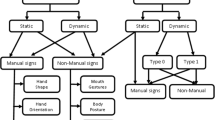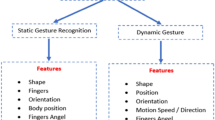Abstract
Sign language maps letters, words, and expressions of a certain language to a set of hand gestures enabling an individual to communicate by using hands and gestures rather than by speaking. Systems capable of recognizing sign-language symbols can be used for communication with the hearing-impaired. This paper represents the first attempt to recognize two-handed signs from the Unified Arabic Sign Language Dictionary using the CyberGlove and support vector machines (SVMs). 20 samples from each of 100 two-handed signs were collected from two adult signers. Because the signs are of different lengths, time division is used to standardize sign length. The duration of every sign is divided into a specific number of segments, and the mean and standard deviation of each segment are used to represent the signal in the segment. After pre-processing, principal component analysis is used for feature extraction. For recognition, a SVM is trained on 15 samples from each sign. The performance is obtained by testing the trained SVM on the remaining five samples from each sign. A recognition rate of 99.6% on the testing data is obtained.

Similar content being viewed by others
References
Kramer, J.; Leifer, L.: The Talking Glove for non-Verbal Deaf Individuals. Technical Report CDR TR 1990 0312, Center for Design Research, Stanford University (1990)
Vamplew, P.: Recognition of sign language using neural networks. PhD Thesis, University of Tasmania (1996)
Sturman D.J., Sturman D.J., Sturman D.J.: A survey of glove-based input. IEEE Comput. Graph. Appl. 14(1), 3039 (1994)
Qaum D.: Gesture recognition with a DataGlove. IEEE Proc. Aerospace Electron. Conf. 2, 755–760 (1990)
Fels S., Hington G.: Glove-talk: a neural network interface between a Data-Glove and a speech synthesizer IEEE Trans. Neural Netw. 4, 2–8 (1993)
Kadous, W.: GRASP: recognition of australian sign language using instrumented gloves. Bachelor’s Thesis, The University of New South Wales (1995)
Waldron M., Kim S.: Isolated ASL sign language recognition for deaf persons. IEEE Trans. Rehabil. Eng. 3, 261–270 (1995)
Sagawa, H.; Takeuchi, M.; Ohki, M.: Description and recognition methods for sign language based on gesture components. In: Proc. IUI97, pp. 97–104. ACM, Orlando (1997)
Kim J., Jang W., Bien Z.: A dynamic gesture recognition system for the Korean Sign Language (KSL) IEEE Trans. Syst. Man Cybern. 26(2), 354–359 (1996)
Jiangqin,W.;Wen, G.; Yibo, S.;Wei, L.; Bo, P.: A simple sign language recognition system based on Data Glove. Proc. ICSP ’98. 2, 1257–1269 (1998)
Mohandes M., Al-Buraiky S.: Automation of the Arabic sign language using the PowerGlove ICGST Int. J. Artif. Intell. Mach. Learn. (AIML) 7(1), 41–46 (2007)
Al-Saihati, I.: Feature extraction for real time recognition of the Arabic sign language. MS thesis, KFUPM (2006)
Mohandes, M.: Recognition of two-handed Arabic signs suing the CyberGlove. In: The 4th International Conference on Advanced Engineering Computing and Applications in Sciences, ADVCOMP, Florence, Italy, 25–30 Oct 2010
The Flock of Birds, Ascension Technology Corporation (1999)
VirtualHand SDK User and Programmer Guides, Immersion Corporation (2001)
CyberGlove Reference Manual. Virtual Technologies, Inc., 2175 Park Blvd., Palo Alto (CA), USA (1998)
Martinez A.M., Kak A.C.: PCA versus LDA. IEEE Trans. Pattern Anal. Mach. Intell. 23(2), 228–233 (2001)
Vapnik V.N.: Statistical Learning Theory. Wiley, New York (1998)
Author information
Authors and Affiliations
Corresponding author
Rights and permissions
About this article
Cite this article
Mohandes, M.A. Recognition of Two-Handed Arabic Signs Using the CyberGlove. Arab J Sci Eng 38, 669–677 (2013). https://doi.org/10.1007/s13369-012-0378-z
Received:
Accepted:
Published:
Issue Date:
DOI: https://doi.org/10.1007/s13369-012-0378-z




